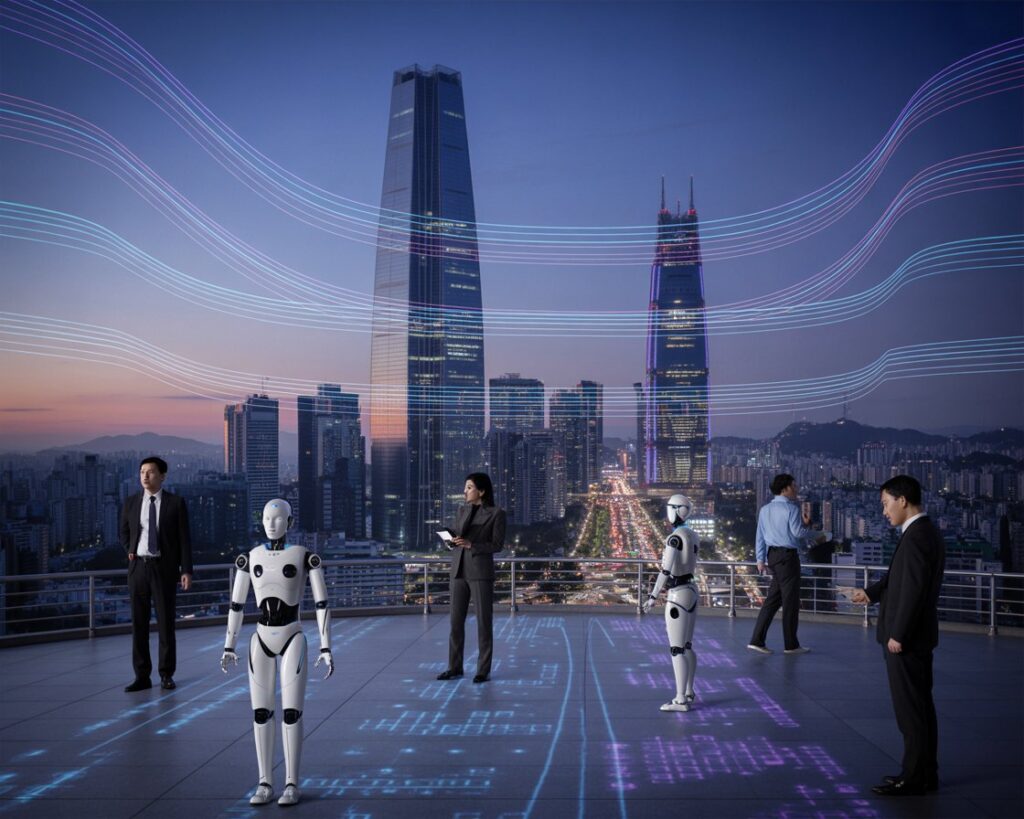South Korea plans to invest 10.1 trillion won (~US$7 billion) in AI by 2026. U.S. tech professionals, policymakers & investors should take note.
South Korea Plans to Triple AI Spending in Next Five Years (2025)
In a bold move to accelerate its transformation into a global artificial-intelligence (AI) powerhouse, South Korea has announced plans to triple its AI budget by 2026. The strategic initiative signals the country’s ambition to stand shoulder-to-shoulder with the U.S. and China in AI leadership, and it presents significant implications for investors, tech professionals and policymakers in the United States. In this article, we unpack what’s happening, why it matters, how it may impact global AI dynamics, and what opportunities or challenges it presents for U.S. stakeholders.

1. What’s the Plan? Key Details
Budget Figures & Timeline
- In his 2026 budget speech, Lee Jae‑Myung announced that South Korea would allocate 10.1 trillion won (approximately US$ 7 billion) for AI next year — more than three times the current year’s AI spending. The Economic Times+2Anadolu Ajansı+2
- Of that total: roughly 2.6 trillion won will be targeted at introducing AI across industry, daily life and the public sector, while about 7.5 trillion won will support infrastructure development and training. Korea Times+1
- The 2026 total budget proposed stands at 728 trillion won (~US$500+ billion), an 8.1 % increase from the previous year. Anadolu Ajansı+2The Economic Times+2
- The policy underscores a multi-year ambition rather than one-off: the government also pledges long-term investment in AI talent and infrastructure. world.kbs.co.kr+1
Strategic Intent
- The goal is to propel South Korea into the top three AI powers globally, alongside the U.S. and China. The Economic Times+1
- Key components include integrating AI into manufacturing, services, public administration, and strengthening infrastructure (data centres, semiconductors, high-performance computing). OpenAI+1
- The budget also ties in with defence and security upgrades — the government plans to modernise its weapons systems and promote “smart” defence capabilities in parallel with the AI push. Anadolu Ajansı

2. Why Is South Korea Doubling-Down on AI?
Export-Driven Economy & Tech Foundations
South Korea is heavily export-oriented, with manufacturing (especially chips, automobiles, heavy industry, shipbuilding) forming the backbone of its economy. According to a policy briefing, manufacturing accounts for about 27.6 % of GDP. OpenAI
AI is seen as a lever to boost productivity, raise value-added in exports, and preserve competitiveness as global supply chains adjust.
Semiconductor & Data Centre Strength
South Korea hosts global memory-chip leaders like Samsung Electronics and SK Hynix; both are deeply involved in AI-relevant hardware and infrastructure. The AI budget ties directly into those ecosystems. The Economic Times
Geopolitical & Strategic Imperatives
In an era of intensifying AI competition (U.S. vs China vs others), South Korea’s push reflects a desire to secure national tech sovereignty, elevate status, and minimise reliance on external actors. The defence link reinforces this motivation. Anadolu Ajansı
Talent & Infrastructure Gaps
For South Korea to leap ahead, it needs to invest in AI training, human capital, data-ecosystems, and high-performance computing (HPC) infrastructure. The budget reflects this. world.kbs.co.kr+1
3. What Does This Mean for the U.S. Tech Landscape & Investors?
Competitive Implications
- With South Korea pushing to become a top-three AI country, U.S. firms and investors may face stronger competition in key areas: semiconductors, AI hardware, data-centres, and perhaps model development.
- South Korea’s government backing may accelerate innovation cycles, reduce lead-time in infrastructure deployment, and make the country a formidable hub for AI R&D and manufacturing.
Collaboration & Supply Chain Opportunities
- U.S. AI-hardware or software firms might view South Korea as a strategic partner: co-development of AI chips, HPC systems, or AI platforms tailored for manufacturing and industrial applications.
- The emphasis on infrastructure means opportunities for U.S.-based cloud/data-centre providers, GPU/AI-hardware companies, and AI-software firms to engage in joint ventures or export to South Korea.
Investment Angle
- For U.S. investors, tracking South Korean AI ecosystem firms (hardware, memory, HPC, robotics, smart manufacturing) may provide diversification and early-stage exposure.
- Government policy backing reduces risk in that local ecosystem, making South Korea a more attractive destination for cross-border portfolio exposure in AI.
Policy & Regulatory Considerations
- U.S. policymakers may need to monitor how South Korea’s AI strategy aligns with U.S. export controls, semiconductor supply-chain policies, and AI standardisation frameworks.
- Collaboration between the U.S. and South Korea (e.g., in AI governance, defence-tech, semiconductors) may become increasingly important.

4. Key Challenges & Risks
Execution Risk
Announcing a budget and achieving transformation are two different things. Infrastructure build-out, training a large AI workforce, upgrading manufacturing, and shifting legacy industries all take years.
South Korea will need to execute across multiple fronts: R&D, Talent, regulation, infrastructure, adoption.
Global Supply Chain & Geopolitics
As U.S. and China impose export controls on advanced chips and AI hardware, South Korea (which sits between the two) faces strategic tension. Ensuring access to top-tier GPUs, for instance, will depend on geopolitics. Reuters+1
Talent Shortages & Brain Drain
Increasing AI capacity means recruiting and training talent. If South Korea cannot attract enough AI specialists (domestic or international), ambitions may stall.
ROI & Time Horizon
From an investor’s viewpoint, returns from government-driven AI strategies may take time. Early investment phases might absorb capital without immediate revenue — patience will be required.
5. Strategic Sectors to Watch in South Korea’s AI Push
Semiconductor & Memory
As noted earlier, memory chips are central to AI training and inference. South Korea’s strengths in this area (Samsung, SK Hynix) position it well. A recent briefing noted that the memory segment of AI‐driven chips is projected to grow by more than 24 %. OpenAI
Smart Manufacturing & Factories
AI is being applied in robotics, smart factories, shipbuilding and automotive sectors in South Korea. The national strategy emphasises transforming traditional manufacturing via AI. OpenAI
Infrastructure & Data Centres
Funding for AI infrastructure includes high-performance computing, GPUs, data centres and large-scale models. South Korea is also aiming to secure large numbers of GPUs as part of its national AI computing centre. Reuters
Public Sector & Everyday Life
Part of the budget (2.6 trillion won) focuses on introducing AI in daily life and public services — e-government, healthcare, transportation, city services. Early public-sector adoption can create spill-over effects for the private sector.
Defence & Dual-Use Technologies
Given the defence budget linkage, AI in military systems (autonomous vehicles, smart sensors, decision-systems) is a strategic focus. This sector often overlaps with commercial spin-outs.
6. Implications for U.S. Investors & Tech Professionals
Portfolio Diversification
For U.S. investors seeking exposure beyond domestic AI champions (e.g., U.S. tech giants), South Korea offers a government-backed ecosystem in hardware, manufacturing, and deep tech.
Considering companies integrated into South Korea’s AI roadmap may offer alternative risk/return profiles.
Partnerships & M&A
U.S. tech companies might seek partnerships or joint ventures with South Korean firms in AI chip design, data centres, or industrial AI applications.
Conversely, South Korean firms may invest abroad — U.S. companies should watch for outbound capital and collaboration offers.
Talent & Location Strategy
Tech firms should evaluate South Korea as a location for AI R&D labs or manufacturing partnerships. For U.S. AI professionals, there may be opportunities to engage with the Korean ecosystem.
Monitoring Policy & Standards
Given the push to make South Korea an AI powerhouse, global AI standards, model governance, data-sharing regimes and export controls can evolve. U.S. firms will need to stay aligned with both U.S. regulatory policies and global trends.
7. What U.S. Policymakers Should Be Aware Of
Supply-Chain Resilience
South Korea’s strengthening of AI hardware and semiconductor capabilities means the U.S. must continue to maintain strong bilateral relations, export controls and co-innovation frameworks to ensure mutual benefit and security.
AI Governance & Ethics
As South Korea invests heavily in AI across sectors, including public services, issues of algorithmic transparency, data privacy, and ethics will surface. U.S. policymakers should engage in dialogues with Korean counterparts to align standards and avoid fragmentation.
Defence & Alliance Implications
With South Korea tying AI and defence modernization together, U.S.–Korea defence cooperation may increasingly involve AI systems, dual‐use technologies and critical infrastructure. Policymakers should evaluate export, interoperability and strategic alignment.
Talent Mobility & Immigration
Global competition for AI talent is booming. The U.S. must ensure its immigration, education and workforce policies remain competitive vis-à-vis innovation hubs such as South Korea.
8. Opportunities for U.S. Tech Professionals
Cross-Border Projects & Engagement
U.S. AI software engineers, infrastructure architects and data-scientists may find roles in collaborative projects with South Korean firms and government initiatives.
Understanding local regulatory, cultural and market dynamics will be key.
Industrial AI Use Cases
With South Korea’s strong manufacturing base, there are high-impact use cases for industrial AI (smart factories, supply-chain automation) that U.S. professionals can tap into.
Hardware + Software Integration
As South Korea strengthens its semiconductor base and AI infrastructure, U.S. professionals who can bridge hardware and software (e.g., model optimisation for memory-efficient chips) will be in high demand.
Insight & Advisory Roles
Given rapid policy changes and budget increases, advisory roles (strategy, regulatory compliance, ethics in AI) will be needed. U.S. consultants and tech leaders may partner with Korean firms or government bodies.

9. Risks U.S. Stakeholders Should Monitor
Over-reliance on Government Spending
Large public investment is positive, but if not matched by commercial uptake and private-sector innovation, growth may stall. U.S. investors should monitor whether South Korea’s AI ecosystem can sustain itself beyond initial funding.
Geopolitical Disruption
Any shifts in U.S.–China–Korea relations (e.g., export controls, trade disputes) may impact supply chains for AI hardware and chip technology. U.S. firms with exposure to South Korea should track geopolitical risk.
Talent Drain & Retention
If South Korea cannot retain domestic AI talent or attract international specialists, growth may hinge on imports. U.S. professionals should weigh opportunities against potential cultural or regulatory barriers.
Adoption Pace & ROI
Technology adoption in legacy industries (manufacturing, public sector) can be slow; transformation may take longer than expected. Investors looking for near-term returns should calibrate accordingly.
10. Strategic Takeaways for U.S. Investors & Tech Firms
- Look beyond software: Many U.S. AI discussions focus on large language models and cloud services. South Korea’s strength is hardware, semiconductors and manufacturing-oriented AI — offering complementary exposure.
- Partner early: U.S. firms that establish partnerships or footholds in South Korea now may benefit from the wave of infrastructure build-out and government-enabled AI programmes.
- Focus on industrial AI: Given South Korea’s manufacturing export base, U.S. firms offering industrial-AI solutions (e.g., smart robotics, predictive maintenance, digital twins) should consider South Korea as a reference market and potential partner.
- Mind supply-chain dependencies: If U.S. firms rely on Korean chip or memory exports (or vice-versa), ensure robustness in supply-chain and anticipate export-control shifts.
- Monitor metrics not just announcements: While the 10.1 trillion won AI budget is impressive, U.S. stakeholders should track project announcements, infrastructure contract wins, talent pipeline data and private-sector uptake in Korea to assess momentum.
- Engage in governance dialogues: Given cross-border AI implications, U.S. tech firms and policymakers should engage with South Korean counterparts on data governance, AI ethics, regulation and joint standard-setting.
11. Broader Global Impact
Competitive Pressure on Other Nations
South Korea’s ramp-up may place pressure on other medium-sized tech nations to respond — accelerating the global AI race in infrastructure, talent and regulation. For U.S. firms, this could mean faster innovation cycles and increased competition.
Supply-Chain Realignment
As South Korea strengthens its role in AI-hardware and memory, global supply-chains may shift — U.S. firms may increasingly source technologies from Korea, or Korean firms may become more prominent suppliers to U.S. companies.
Model Deployment & Standard-Setting
As South Korea introduces AI into public-services and industry at scale, outcomes (good or bad) will influence global best practices. U.S. firms should watch how Korea handles ethics, privacy, regulation and scalability — these may become reference models.
Defence & Dual-Use Technology Trends
The merging of AI and defence in Korea signals a broader trend where national security and AI investments intertwine. U.S. policymakers and firms working in dual-use tech will need to adapt to this reality.
12. What to Watch Next — Upcoming Signals
- Legislative approval: While the budget is proposed, major allocations require parliamentary approval. Track Korea’s National Assembly actions.
- Contract announcements: Which companies (domestic or foreign) win major AI infrastructure contracts in Korea? Look for GPU, data-centre, chip-fab, and smart-factory announcements.
- Talent initiatives: Korea’s plans to invest 6 trillion won over five years in AI education/training (as per KBS report) are critical signs. world.kbs.co.kr
- Export controls & supply-chain moves: Watch how U.S. export-control policies affect Korean access to leading GPUs or whether Korea develops indigenous alternatives.
- Global partnership deals: Are Korean firms partnering with U.S. companies in AI models, cloud services, data-centres or industrial AI?
- Adoption metrics: Reports on AI usage in public services, manufacturing productivity gains in Korea will provide validation of the budget investment.
13. Summary Table for U.S. Stakeholders
| Topic | Key Insight | Why It Matters to U.S. Stakeholders |
|---|---|---|
| Budget increase | 10.1 trillion won (~US$7B) for AI in 2026 — >3× current year. The Economic Times+1 | Signals major scale of investment; opens opportunities for U.S. firms. |
| Strategic sectors | Semiconductors, smart manufacturing, AI infrastructure, public‐service AI. OpenAI | These areas complement U.S. tech strengths and present collaboration/competition. |
| Export-driven economy | Manufacturing + chips are core to Korea; AI is seen as lever for upgrade. OpenAI | U.S. firms in industrial AI can access new market and global supply-chain interplay. |
| Geopolitical dimension | Korea aims for AI + defence self-reliance. Anadolu Ajansı | U.S.–Korea alliance may deepen in tech & defence; export controls matter. |
| Risks | Execution, talent, supply-chain, ROI. | U.S. investors must assess timing, partner credibility, global dynamics. |
Conclusion
For U.S. tech professionals, investors and policymakers, South Korea’s plan to triple AI spending is a significant signal: a well-resourced, export-oriented, technologically adept nation is moving aggressively into the AI era. While the U.S. will remain a leader, the global competitive landscape is shifting and collaboration possibilities are abundant. U.S. firms with a strategic mindset should view South Korea not just as a competitor, but as a potential partner, a supply-chain hub and a source of innovation in hardware, manufacturing-AI and infrastructure.
That said, the actual payoff will depend on execution, regulatory alignment and global supply-chain stability. U.S. stakeholders should monitor developments closely — from contract awards and talent initiatives to export-control issues and cross-border partnerships. The next few years will likely determine whether South Korea fulfils its ambition of becoming a top-three AI power, and how that reshapes global AI ecosystems.
In short: South Korea’s AI blitz is a wake-up call and an opportunity. U.S. players who anticipate, adapt and engage thoughtfully stand to gain from the evolving global AI map.
